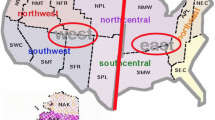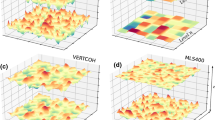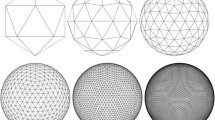Summary
The effects of varying horizontal and vertical grid resolution on the numerical simulation of upper-tropospheric frontal structures are examined using a, two-dimensional, dry, hydrostatic sigma-coordinate primitive equation model. These effects are illustrated with the results of 72 h model integrations in which frontogenesis is forced solely by confluence. Four different horizontal grid spacings, ranging from 100 km to 12.5 km, and four different vertical, grid resolutions, varying from 10 to 70 layers (∼90 mb to 13 mb), are considered.
The intensity and integrity of the frontogenesis as a function of grid resolution are diagnosed in terms of time histories and spatial distributions of frontal parameters, such as the speed of the along-front jet, maxima of absolute vorticity and potential temperature gradient, and ageostrophic motions. The time histories show that, provided the vertical resolution is sufficient, increasing horizontal resolution leads to better-defined frontal structure due to the decrease in cross-frontal scale. They also indicate that for a given horizontal resolution there exists an optimal vertical resolution beyond which frontal parameters change only slightly. This optimal vertical resolution increases with increasing horizontal resolution, and apparently is related to the horizontal resolution through the slope of the frontal zone.
The time histories for simulations combining low vertical resolution with high horizontal resolution exhibit substantial high-frequency variability. Cross sections show that this temporal variability appears to be manifested spatially in the form of gravity waves characterized by wavelengths on the order of 200 km and periods of 12 h, over the range of horizontal and vertical resolution that is considered. Although the source mechanism for these waves cannot be established definitively, it likely involves a grid-induced ageostrophic component of the along-front wind which disrupts thermal wind balance. This results thus demonstrates the potential risk of flawed frontal simulations, when incompatible combinations of horizontal and vertical resolution are used.
Similar content being viewed by others
References
Anthes, R. A., Keyser, D., 1979: Tests of a fine-mesh model over Europe and the United States.Mon. Wea. Rev.,107, 963–984.
Anthes, R. A., Warner, T. T., 1978: Development of hydrodynamic models suitable for air pollution and other mesometeorological studies.Mon. Wea. Rev.,106, 1045–1078.
Bleck, R., 1978: On the use of hybrid vertical coordinates in numerical weather prediction models.Mon. Wea. Rev.,106, 1233–1244.
Bleck, R., 1979: A sensitivity study concerning vertical resolution in atmospheric prediction models. Preprints Fourth Conf. Numerical Weather Prediction, Silver Spring, Amer. Meteor. Soc., 161–164.
Buzzi, A., Trevisan, A., Salustri, G., 1981 Internal frontogenesis: A two-dimensional model in isentropic, semi-geostrophic coordinates.Mon. Wea. Rev.,109, 1053–1060.
Eliassen, A., 1962: On the vertical circulation in frontal zones.Geofys., Publ.,24, 147–160.
Gidel, L. T., Shapiro, M. A., 1979: The role of clear air turbulence in the production of potential vorticity in the vicinityof upper tropospheric jet stream-frontal systems.J. Atmos. Sci.,36, 2125–2138.
Hoskins, B. J., 1971: Atmospheric frontogenesis models: Some solutions.Quart. J. Roy. Meteor. Soc.,97, 139–153.
Hoskins B. J., 1972: Non-Boussinesq effects and further development in a model of upper tropospheric frontogenesis.Quart. J. Roy. Meteor. Soc.,98, 532–541.
Hoskins, B. J., 1975: The geostrophic momentum approximation and the semi-geostrophic equations.J. Atmos. Sci.,32, 233–242.
Hoskins, B. J., Bretherton, F. P., 1972: Atmospheric frontogenesis models: Mathematical formulation and solution.J. Atmos. Sci.,29, 11–37.
Hsie, E.-Y., Anthes, R. A., Keyser, D., 1984: Numerical simulation of frontogenesis in a moist atmosphere.J. Atmos. Sci.,41, 2581–2594.
Keyser, D., Anthes, R. A., 1982: The influence of planetary boundary layer physics on frontal structure in the Hoskins-Bretherton horizontal shear model.J. Atmos. Sci.,39, 1783–1802.
Keyser, D., Pecnick, M. J., 1985 A two-dimensional primitive equation model of frontogenesis forced by confluence and horizontal shear.J. Atmos. Sci.,42, 1259–1282.
Keyser, D., Pecnick, M. J., 1987: The effect of along-front temperature variation in a two-dimensional primitive equation model of surface frontogenesis.J. Atmos. Sci.,44, 577–604.
Keyser, D., Pecnick, M. J., Shapiro, M. A.: 1986: Diagnosis of the role of vertical deformation in a two-dimensional primitive equation model of upper-level frontogenesis.J. Atmos. Sci.,43 839–850.
Miyakoda, K., Rosati, A., 1977: One-way nested grid models: The interface conditions and the numerical accuracy.Mon. Wea. Rev.,105, 1092–1107.
Petersen, R. A., Tuccillo, J. J., Brill, K. F., Uccellini, L. W., 1985: The sensitivity of a mesoscale forecast model to detailed three-dimensional isentropic initial analyses and varied vertical model resolution. Preprints Seventh Conf. Numerical Weather Prediction, Montreal, P.Q., Canada, Amer. Meteor. Soc., 83–90.
Sawyer, J. S., 1956: The vertical circulation at meteorological fronts and its relation to frontogenesis.Proc. Roy. Soc. London,A234, 346–362.
Author information
Authors and Affiliations
Additional information
With 7 Figures
Rights and permissions
About this article
Cite this article
Pecnick, M.J., Keyser, D. The effect of spatial resolution on the simulation of upper-tropospheric frontogenesis using a sigma-coordinate primitive equation model. Meteorl. Atmos. Phys. 40, 137–149 (1989). https://doi.org/10.1007/BF01032454
Received:
Revised:
Issue Date:
DOI: https://doi.org/10.1007/BF01032454




